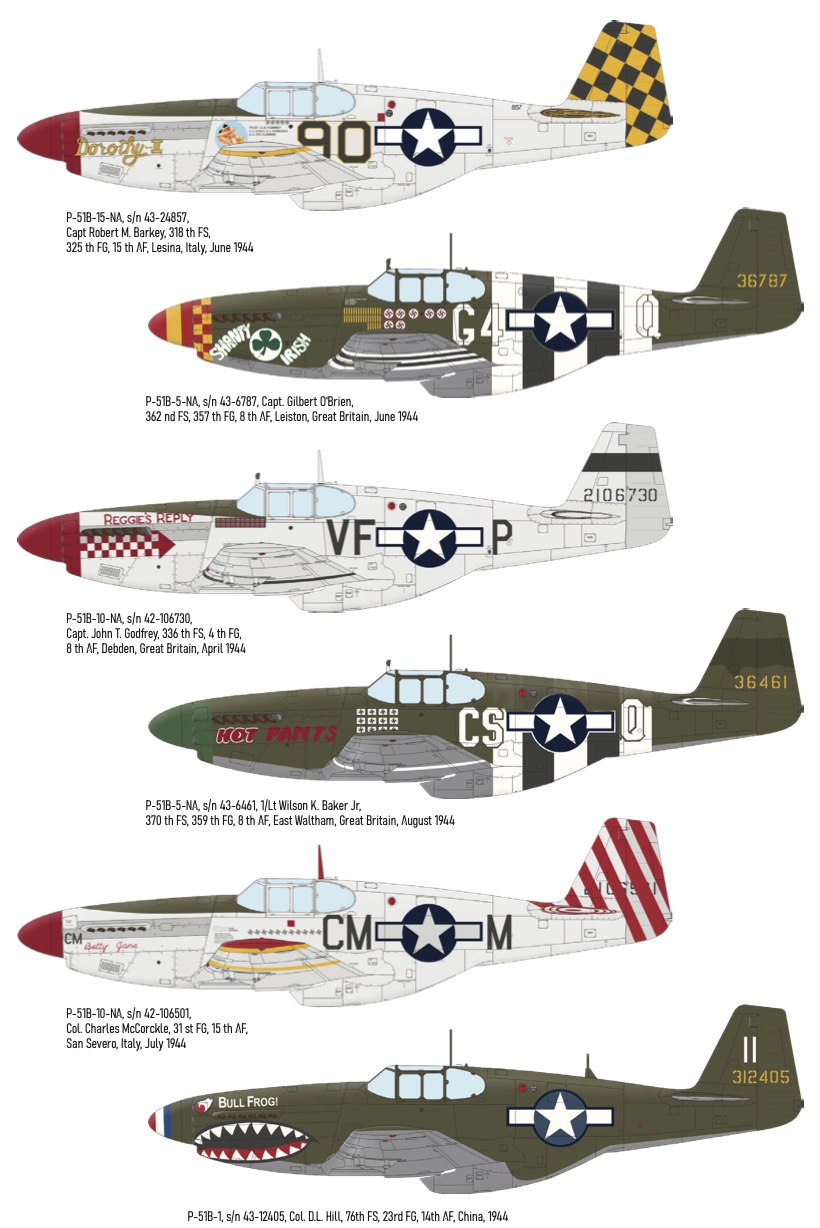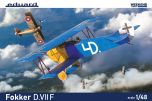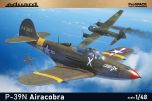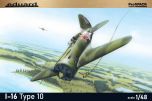Eduard 1/48 North-American P-51B Mustang Birdcage Canopy ProfiPACK Edition # 82107
The ProfiPACK edition kit of US fighter aircraft P-51B Mustang in 1/48 scale.
It allows to build the aircraft with standard Birdcage canopy in one of six USAAF markings.
- Plastic parts: Eduard
- Marking options: 6
- Decals: Eduard
- PE parts: yes, pre-painted
- painting mask: yes
- Resin parts: no
COL A P-51B-15-NA, 43-24857, Capt. Robert M. Barkey, 318th FS, 325th FG, 15th AF, Lesina, Italy, June 1944
COL B P-51B-5-NA, 43-6787, Capt. Gilbert O'Brien, 362nd FS, 357th FG, 8th AF, Leiston, United Kingdom, June 1944
COL C P-51B-10-NA, 42-106730, Capt. John T. Godfrey, 336th FS, 4th FG, 8th AF, Debden, United Kingdom, April 1944
COL D P-51B-5-NA, 43-6461, 1/Lt Wilson K. Baker Jr, 370th FS, 359th FG, 8th AF, East Waltham, United Kingdom, August 1944
COL E P-51B-10-NA, 42-106501, Col. Charles McCorckle, CO of 31st FG, 15th AF, San Severo, Italy, July 1944
COL F P-51B-1, 43-12405, Col. David L. Hill, CO of 23rd FG, 14th AF, China, 1944
 Spread the cost with Paypal Credit
0% for 24 months available on orders over £199
Spread the cost with Paypal Credit
0% for 24 months available on orders over £199
 Spread the cost with Klarna
0% for 24 months available on orders over £199
Spread the cost with Klarna
0% for 24 months available on orders over £199
![]()
The North American P-51B Mustang, equipped with the "birdcage" canopy, was a pivotal fighter aircraft in World War II, known for its long-range capabilities, speed, and versatility.
The "birdcage" canopy refers to the earlier style of cockpit covering, which featured a framework of metal bars, providing structural support but somewhat limiting the pilot's visibility compared to later versions.
Engine and Performance:
Engine: The P-51B was powered by the Packard V-1650-3, a license-built version of the Rolls-Royce Merlin engine. This engine significantly enhanced the aircraft's performance, particularly at high altitudes.
Speed: The aircraft could reach a top speed of around 441 mph (710 km/h) at 25,000 feet (7,620 meters).
Range: With its drop tanks, the P-51B had an impressive range of approximately 1,300 miles (2,100 km), making it an excellent long-range escort fighter.
Armament:
Machine Guns: The P-51B was armed with four .50 caliber M2 Browning machine guns, two in each wing, providing substantial firepower for both air-to-air and air-to-ground engagements.
Ordnance: It could also carry bombs or rockets, enhancing its ground attack capabilities.
Design and Aerodynamics:
Airframe: The P-51B featured a sleek and aerodynamic design, optimized for speed and agility. The incorporation of the Merlin engine necessitated a redesign of the airframe, resulting in a more streamlined appearance compared to the earlier P-51A models.
Birdcage Canopy: The "birdcage" canopy had a framed structure that provided durability and structural integrity but limited the pilot’s field of view. This was later replaced in subsequent models by the "bubble" canopy, which offered improved visibility.
Operational Use:
Roles: The P-51B was used primarily as a long-range bomber escort, intercepting enemy fighters before they could attack Allied bombers. It also performed ground attack missions, strafing enemy positions, and infrastructure.
Combat: It saw extensive action in both the European and Pacific theaters, earning a reputation for its effectiveness and reliability.
Deployment: The P-51B was flown by many Allied aces, contributing significantly to the Allied air superiority during the war.
Legacy:
Impact: The introduction of the P-51B Mustang marked a turning point in the air war over Europe, allowing Allied bombers to be escorted deep into enemy territory with greater protection.
Evolution: The "birdcage" canopy variant represents an important stage in the Mustang's evolution, highlighting the transition from early designs to the more advanced models that followed.
The North American P-51B Mustang with the "birdcage" canopy was a crucial asset to the Allied forces during World War II.
Its combination of range, speed, and firepower made it a formidable opponent in the skies.
While the "birdcage" canopy had its limitations, this variant of the Mustang laid the groundwork for the later P-51D model, which would become one of the most iconic fighter aircraft of the war.


| SKU | EDK82107 |
|---|---|
| Manufacturer | Eduard |
| Scale | 1/48 |
| Short Description | The ProfiPACK edition kit of US fighter aircraft P-51B Mustang in 1/48 scale. It allows to build the aircraft with standard Birdcage canopy in one of six USAAF markings. - Plastic parts: Eduard COL A P-51B-15-NA, 43-24857, Capt. Robert M. Barkey, 318th FS, 325th FG, 15th AF, Lesina, Italy, June 1944 |
-
 Eduard 1/48 Fokker D.VIIF Weekend Edition # 8483Special Price £17.64 was £19.60 Save 10%
Eduard 1/48 Fokker D.VIIF Weekend Edition # 8483Special Price £17.64 was £19.60 Save 10% -
 Eduard 1/48 Messerschmitt Bf-109K-4 Weekend Edition # 84197Special Price £17.64 was £19.60 Save 10%
Eduard 1/48 Messerschmitt Bf-109K-4 Weekend Edition # 84197Special Price £17.64 was £19.60 Save 10% -
 Eduard 1/48 Bell P-39N Airacobra ProfiPACK Edition # 8067Special Price £20.52 was £22.80 Save 10%
Eduard 1/48 Bell P-39N Airacobra ProfiPACK Edition # 8067Special Price £20.52 was £22.80 Save 10% -
 Eduard 1/48 Grumman FM-1 Wildcat ProfiPACK Kit # 82204Special Price £25.83 was £28.70 Save 10%
Eduard 1/48 Grumman FM-1 Wildcat ProfiPACK Kit # 82204Special Price £25.83 was £28.70 Save 10% -
 Eduard 1/48 Messerschmitt Bf-109E-4 Weekend Edition # 84196Special Price £17.64 was £19.60 Save 10%
Eduard 1/48 Messerschmitt Bf-109E-4 Weekend Edition # 84196Special Price £17.64 was £19.60 Save 10% -
 Eduard 1/48 Focke-Wulf Fw-190A-7 # 82138Special Price £25.83 was £28.70 Save 10%
Eduard 1/48 Focke-Wulf Fw-190A-7 # 82138Special Price £25.83 was £28.70 Save 10% -
 Eduard 1/48 Supermarine Spitfire Mk.Vb OVERLORD Weekend Edition # 84200Special Price £17.64 was £19.60 Save 10%
Eduard 1/48 Supermarine Spitfire Mk.Vb OVERLORD Weekend Edition # 84200Special Price £17.64 was £19.60 Save 10% -
 Eduard 1/48 Messerschmitt Bf-109G Weekend Edition # 84201Special Price £17.64 was £19.60 Save 10%
Eduard 1/48 Messerschmitt Bf-109G Weekend Edition # 84201Special Price £17.64 was £19.60 Save 10% -
 Eduard 1/48 Supermarine Spitfire Mk.XVI High Back # 8286Special Price £26.99 was £29.99 Save 10%
Eduard 1/48 Supermarine Spitfire Mk.XVI High Back # 8286Special Price £26.99 was £29.99 Save 10% -
 Eduard 1/48 Fokker E.III Weekend Edition # 8419Special Price £15.48 was £17.20 Save 10%
Eduard 1/48 Fokker E.III Weekend Edition # 8419Special Price £15.48 was £17.20 Save 10% -
 Eduard 1/48 Grumman F4F-4 Wildcat Late ProfiPACK Edition # 82203Special Price £25.79 was £28.65 Save 10%
Eduard 1/48 Grumman F4F-4 Wildcat Late ProfiPACK Edition # 82203Special Price £25.79 was £28.65 Save 10% -
 Eduard 1/48 Supermarine Spitfire Mk.IXc Late Weekend Edition # 84199Special Price £17.64 was £19.60 Save 10%
Eduard 1/48 Supermarine Spitfire Mk.IXc Late Weekend Edition # 84199Special Price £17.64 was £19.60 Save 10% -
 Eduard 1/48 Overlord: D-Day Mustangs P-51B Mustang Dual Combo Limited Edition # 11181Special Price £48.15 was £53.50 Save 10%
Eduard 1/48 Overlord: D-Day Mustangs P-51B Mustang Dual Combo Limited Edition # 11181Special Price £48.15 was £53.50 Save 10% -
 Eduard 1/48 Freedom Tiger F-5E Tiger II Limited Edition # 11182Special Price £48.15 was £53.50 Save 10%
Eduard 1/48 Freedom Tiger F-5E Tiger II Limited Edition # 11182Special Price £48.15 was £53.50 Save 10% -
 Eduard 1/48 Savoia-Marchetti SM.79 Bomber Limited Edition # 11179Special Price £53.99 was £59.99 Save 10%
Eduard 1/48 Savoia-Marchetti SM.79 Bomber Limited Edition # 11179Special Price £53.99 was £59.99 Save 10% -
 Eduard 1/48 Polikarpov I-16 type 10 ProfiPACK Edition # 8148Special Price £22.95 was £25.50 Save 10%
Eduard 1/48 Polikarpov I-16 type 10 ProfiPACK Edition # 8148Special Price £22.95 was £25.50 Save 10% -
 Eduard 1/48 Fokker D.VIIF Weekend Edition # 8483Special Price £17.64 was £19.60 Save 10%
Eduard 1/48 Fokker D.VIIF Weekend Edition # 8483Special Price £17.64 was £19.60 Save 10% -
 Eduard 1/48 Messerschmitt Bf-109K-4 Weekend Edition # 84197Special Price £17.64 was £19.60 Save 10%
Eduard 1/48 Messerschmitt Bf-109K-4 Weekend Edition # 84197Special Price £17.64 was £19.60 Save 10% -
 Eduard 1/48 Bell P-39N Airacobra ProfiPACK Edition # 8067Special Price £20.52 was £22.80 Save 10%
Eduard 1/48 Bell P-39N Airacobra ProfiPACK Edition # 8067Special Price £20.52 was £22.80 Save 10% -
 Eduard 1/48 Grumman FM-1 Wildcat ProfiPACK Kit # 82204Special Price £25.83 was £28.70 Save 10%
Eduard 1/48 Grumman FM-1 Wildcat ProfiPACK Kit # 82204Special Price £25.83 was £28.70 Save 10% -
 Eduard 1/48 Messerschmitt Bf-109E-4 Weekend Edition # 84196Special Price £17.64 was £19.60 Save 10%
Eduard 1/48 Messerschmitt Bf-109E-4 Weekend Edition # 84196Special Price £17.64 was £19.60 Save 10% -
 Eduard 1/48 Focke-Wulf Fw-190A-7 # 82138Special Price £25.83 was £28.70 Save 10%
Eduard 1/48 Focke-Wulf Fw-190A-7 # 82138Special Price £25.83 was £28.70 Save 10% -
 Eduard 1/48 Supermarine Spitfire Mk.Vb OVERLORD Weekend Edition # 84200Special Price £17.64 was £19.60 Save 10%
Eduard 1/48 Supermarine Spitfire Mk.Vb OVERLORD Weekend Edition # 84200Special Price £17.64 was £19.60 Save 10% -
 Eduard 1/48 Messerschmitt Bf-109G Weekend Edition # 84201Special Price £17.64 was £19.60 Save 10%
Eduard 1/48 Messerschmitt Bf-109G Weekend Edition # 84201Special Price £17.64 was £19.60 Save 10% -
 Eduard 1/48 Supermarine Spitfire Mk.XVI High Back # 8286Special Price £26.99 was £29.99 Save 10%
Eduard 1/48 Supermarine Spitfire Mk.XVI High Back # 8286Special Price £26.99 was £29.99 Save 10% -
 Eduard 1/48 Fokker E.III Weekend Edition # 8419Special Price £15.48 was £17.20 Save 10%
Eduard 1/48 Fokker E.III Weekend Edition # 8419Special Price £15.48 was £17.20 Save 10% -
 Eduard 1/48 Grumman F4F-4 Wildcat Late ProfiPACK Edition # 82203Special Price £25.79 was £28.65 Save 10%
Eduard 1/48 Grumman F4F-4 Wildcat Late ProfiPACK Edition # 82203Special Price £25.79 was £28.65 Save 10% -
 Eduard 1/48 Supermarine Spitfire Mk.IXc Late Weekend Edition # 84199Special Price £17.64 was £19.60 Save 10%
Eduard 1/48 Supermarine Spitfire Mk.IXc Late Weekend Edition # 84199Special Price £17.64 was £19.60 Save 10% -
 Eduard 1/48 Overlord: D-Day Mustangs P-51B Mustang Dual Combo Limited Edition # 11181Special Price £48.15 was £53.50 Save 10%
Eduard 1/48 Overlord: D-Day Mustangs P-51B Mustang Dual Combo Limited Edition # 11181Special Price £48.15 was £53.50 Save 10% -
 Eduard 1/48 Freedom Tiger F-5E Tiger II Limited Edition # 11182Special Price £48.15 was £53.50 Save 10%
Eduard 1/48 Freedom Tiger F-5E Tiger II Limited Edition # 11182Special Price £48.15 was £53.50 Save 10% -
 Eduard 1/48 Savoia-Marchetti SM.79 Bomber Limited Edition # 11179Special Price £53.99 was £59.99 Save 10%
Eduard 1/48 Savoia-Marchetti SM.79 Bomber Limited Edition # 11179Special Price £53.99 was £59.99 Save 10% -
 Eduard 1/48 Polikarpov I-16 type 10 ProfiPACK Edition # 8148Special Price £22.95 was £25.50 Save 10%
Eduard 1/48 Polikarpov I-16 type 10 ProfiPACK Edition # 8148Special Price £22.95 was £25.50 Save 10% -
 Eduard 1/48 Fokker D.VIIF Weekend Edition # 8483Special Price £17.64 was £19.60 Save 10%
Eduard 1/48 Fokker D.VIIF Weekend Edition # 8483Special Price £17.64 was £19.60 Save 10% -
 Eduard 1/48 Messerschmitt Bf-109K-4 Weekend Edition # 84197Special Price £17.64 was £19.60 Save 10%
Eduard 1/48 Messerschmitt Bf-109K-4 Weekend Edition # 84197Special Price £17.64 was £19.60 Save 10% -
 Eduard 1/48 Bell P-39N Airacobra ProfiPACK Edition # 8067Special Price £20.52 was £22.80 Save 10%
Eduard 1/48 Bell P-39N Airacobra ProfiPACK Edition # 8067Special Price £20.52 was £22.80 Save 10% -
 Eduard 1/48 Grumman FM-1 Wildcat ProfiPACK Kit # 82204Special Price £25.83 was £28.70 Save 10%
Eduard 1/48 Grumman FM-1 Wildcat ProfiPACK Kit # 82204Special Price £25.83 was £28.70 Save 10% -
 Eduard 1/48 Messerschmitt Bf-109E-4 Weekend Edition # 84196Special Price £17.64 was £19.60 Save 10%
Eduard 1/48 Messerschmitt Bf-109E-4 Weekend Edition # 84196Special Price £17.64 was £19.60 Save 10% -
 Eduard 1/48 Focke-Wulf Fw-190A-7 # 82138Special Price £25.83 was £28.70 Save 10%
Eduard 1/48 Focke-Wulf Fw-190A-7 # 82138Special Price £25.83 was £28.70 Save 10%


























